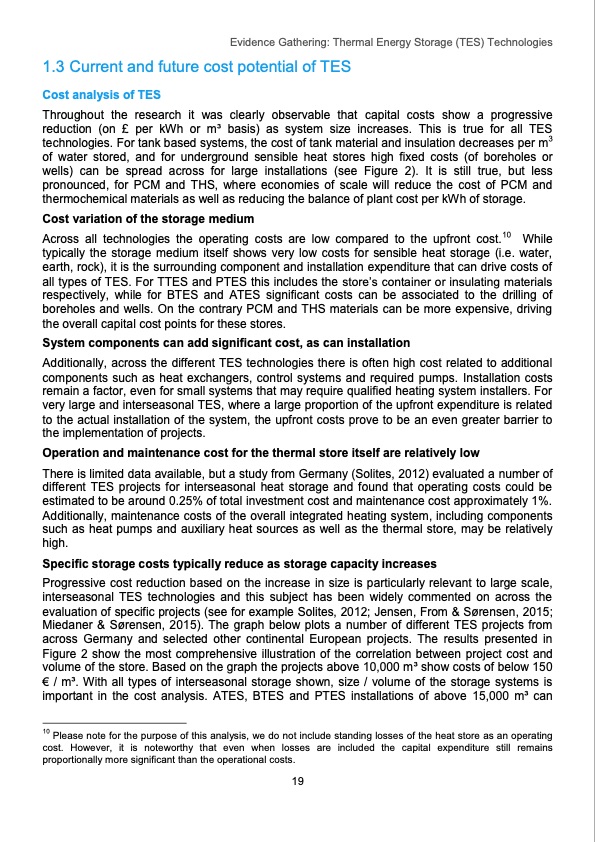
PDF Publication Title:
Text from PDF Page: 020
Evidence Gathering: Thermal Energy Storage (TES) Technologies 1.3 Current and future cost potential of TES Cost analysis of TES Throughout the research it was clearly observable that capital costs show a progressive reduction (on £ per kWh or m3 basis) as system size increases. This is true for all TES technologies. For tank based systems, the cost of tank material and insulation decreases per m3 of water stored, and for underground sensible heat stores high fixed costs (of boreholes or wells) can be spread across for large installations (see Figure 2). It is still true, but less pronounced, for PCM and THS, where economies of scale will reduce the cost of PCM and thermochemical materials as well as reducing the balance of plant cost per kWh of storage. Cost variation of the storage medium Across all technologies the operating costs are low compared to the upfront cost.10 While typically the storage medium itself shows very low costs for sensible heat storage (i.e. water, earth, rock), it is the surrounding component and installation expenditure that can drive costs of all types of TES. For TTES and PTES this includes the store’s container or insulating materials respectively, while for BTES and ATES significant costs can be associated to the drilling of boreholes and wells. On the contrary PCM and THS materials can be more expensive, driving the overall capital cost points for these stores. System components can add significant cost, as can installation Additionally, across the different TES technologies there is often high cost related to additional components such as heat exchangers, control systems and required pumps. Installation costs remain a factor, even for small systems that may require qualified heating system installers. For very large and interseasonal TES, where a large proportion of the upfront expenditure is related to the actual installation of the system, the upfront costs prove to be an even greater barrier to the implementation of projects. Operation and maintenance cost for the thermal store itself are relatively low There is limited data available, but a study from Germany (Solites, 2012) evaluated a number of different TES projects for interseasonal heat storage and found that operating costs could be estimated to be around 0.25% of total investment cost and maintenance cost approximately 1%. Additionally, maintenance costs of the overall integrated heating system, including components such as heat pumps and auxiliary heat sources as well as the thermal store, may be relatively high. Specific storage costs typically reduce as storage capacity increases Progressive cost reduction based on the increase in size is particularly relevant to large scale, interseasonal TES technologies and this subject has been widely commented on across the evaluation of specific projects (see for example Solites, 2012; Jensen, From & Sørensen, 2015; Miedaner & Sørensen, 2015). The graph below plots a number of different TES projects from across Germany and selected other continental European projects. The results presented in Figure 2 show the most comprehensive illustration of the correlation between project cost and volume of the store. Based on the graph the projects above 10,000 m3 show costs of below 150 € / m3. With all types of interseasonal storage shown, size / volume of the storage systems is important in the cost analysis. ATES, BTES and PTES installations of above 15,000 m3 can 10 Please note for the purpose of this analysis, we do not include standing losses of the heat store as an operating cost. However, it is noteworthy that even when losses are included the capital expenditure still remains proportionally more significant than the operational costs. 19PDF Image | Thermal Energy Storage (TES) Technologies

PDF Search Title:
Thermal Energy Storage (TES) TechnologiesOriginal File Name Searched:
DELTA_EE_DECC_TES_Final__1_.pdfDIY PDF Search: Google It | Yahoo | Bing
Turbine and System Plans CAD CAM: Special for this month, any plans are $10,000 for complete Cad/Cam blueprints. License is for one build. Try before you buy a production license. More Info
Waste Heat Power Technology: Organic Rankine Cycle uses waste heat to make electricity, shaft horsepower and cooling. More Info
All Turbine and System Products: Infinity Turbine ORD systems, turbine generator sets, build plans and more to use your waste heat from 30C to 100C. More Info
CO2 Phase Change Demonstrator: CO2 goes supercritical at 30 C. This is a experimental platform which you can use to demonstrate phase change with low heat. Includes integration area for small CO2 turbine, static generator, and more. This can also be used for a GTL Gas to Liquids experimental platform. More Info
Introducing the Infinity Turbine Products Infinity Turbine develops and builds systems for making power from waste heat. It also is working on innovative strategies for storing, making, and deploying energy. More Info
Need Strategy? Use our Consulting and analyst services Infinity Turbine LLC is pleased to announce its consulting and analyst services. We have worked in the renewable energy industry as a researcher, developing sales and markets, along with may inventions and innovations. More Info
Made in USA with Global Energy Millennial Web Engine These pages were made with the Global Energy Web PDF Engine using Filemaker (Claris) software.
Sand Battery Sand and Paraffin for TES Thermo Energy Storage More Info
| CONTACT TEL: 608-238-6001 Email: greg@infinityturbine.com | RSS | AMP |